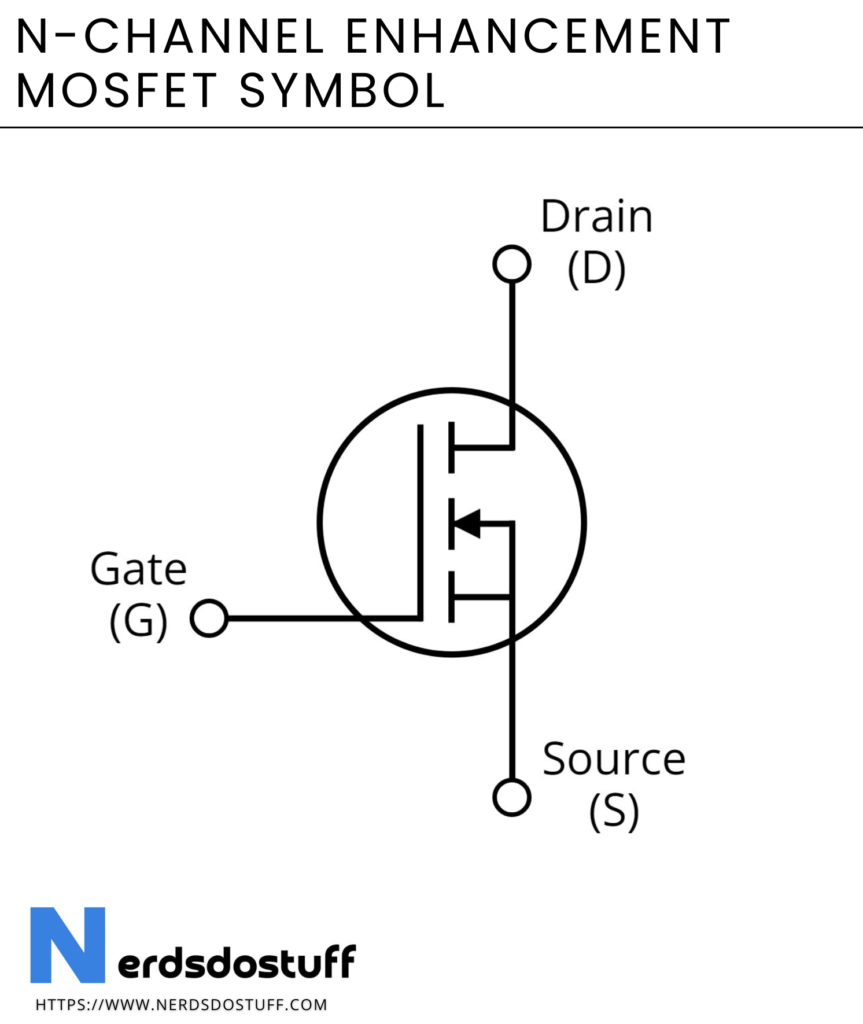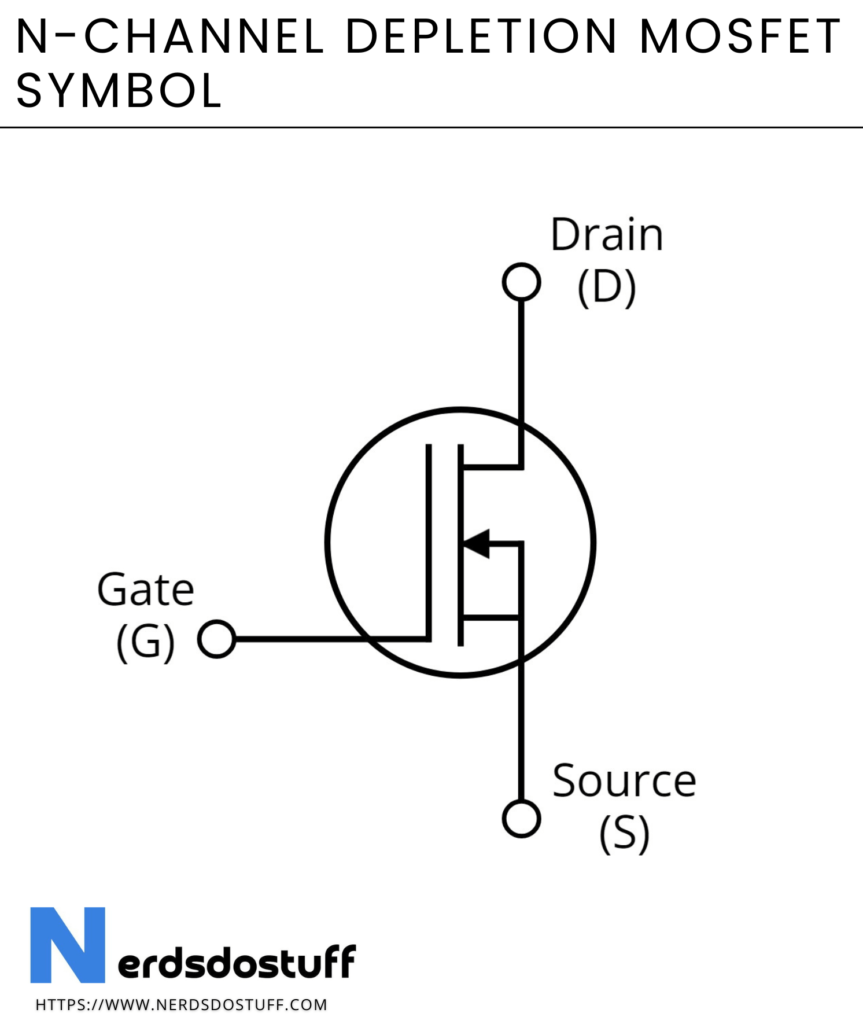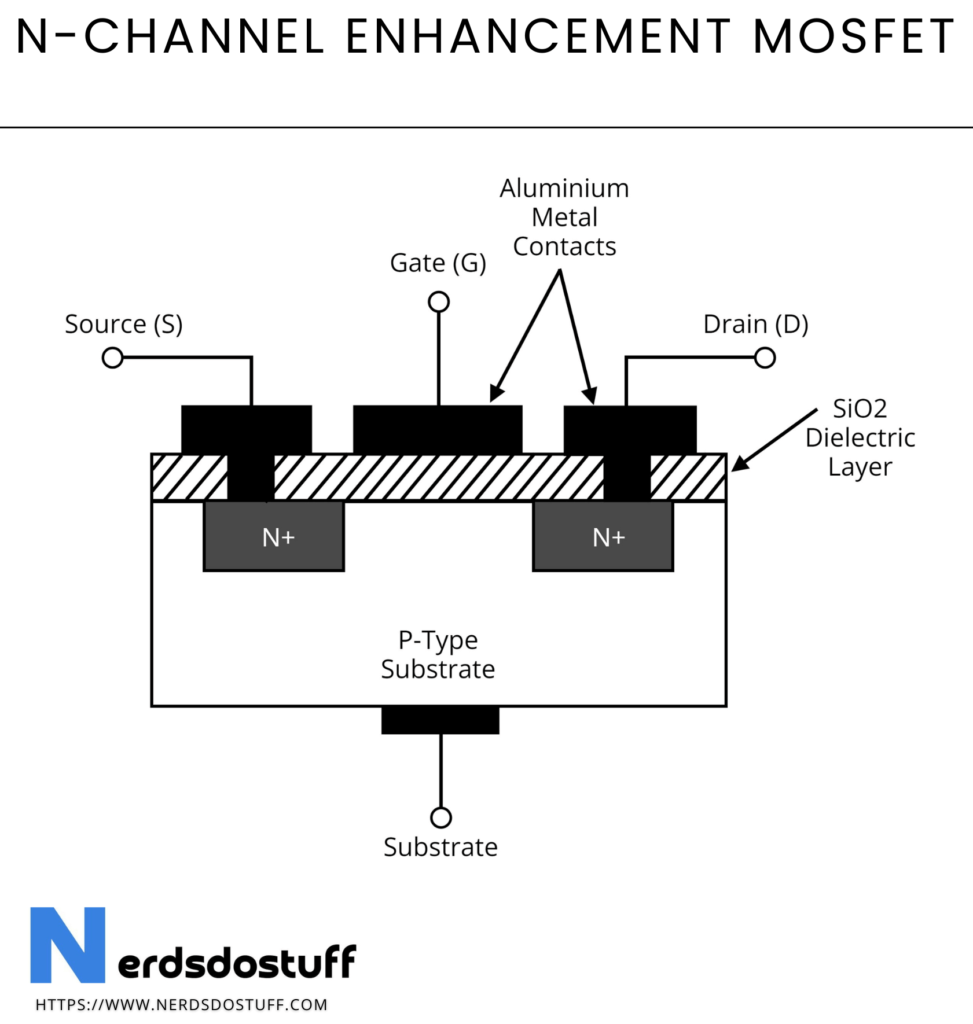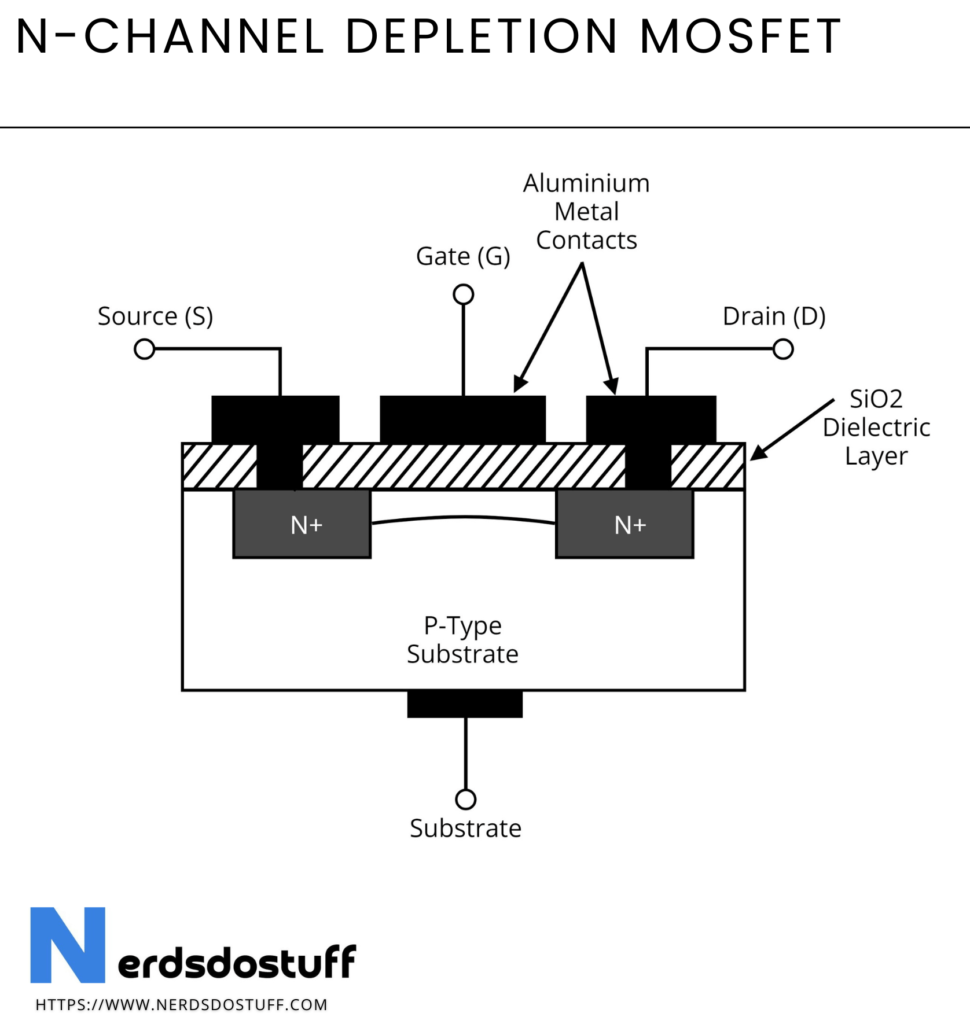Introduction
N-channel Metal-Oxide-Semiconductor Field-Effect Transistors, or N-channel MOSFETs, play a pivotal role in electronic circuits, offering versatility in applications like amplification, switching, and signal processing. This article aims to provide a comprehensive understanding of N-channel MOSFETs, encompassing their composition, structure, operation, and prominent features.
What is MOSFET ?
A MOSFET, or Metal-Oxide-Semiconductor Field-Effect Transistor, is a type of semiconductor device that plays a crucial role in electronic circuits. It is used for amplifying or switching electronic signals. The MOSFET consists of three main components: a metal gate, an insulating oxide layer (usually made of silicon dioxide), and a semiconductor material (commonly silicon). This arrangement forms a transistor that allows precise control of the flow of electrical current.
What is N Channel MOSFET ?
An N-channel MOSFET (Metal-Oxide-Semiconductor Field-Effect Transistor) is a type of MOSFET where the majority charge carriers, responsible for the flow of electrical current, are electrons. N-channel MOSFETs are widely used in electronic circuits for amplification, switching, and signal processing.
Types of N Channel MOSFET
There are two types of N Channel MOSFETs:
- N Channel Enhancement MOSFET
- N Channel Depletion MOSFET
N Channel MOSFET Symbol
N Channel Enhancement MOSFET symbol

The symbol for an N-channel enhancement-mode MOSFET consists of three main elements: the gate, source, and drain terminals. Here’s a breakdown of each component:
- Arrow Direction: The arrow points away from the body of the transistor, indicating the direction of conventional current flow when the transistor is in its active (conducting) state.
- Triangle: The triangle represents an N-channel MOSFET. The side of the triangle with the arrow is the source terminal, and the opposite side is the drain terminal. The point of the triangle represents the gate terminal.
- Arrow on Gate: To signify that it is an enhancement-mode MOSFET, there is no line connecting the arrow to the triangle. The arrow on the gate indicates that a positive voltage applied to the gate relative to the source enhances the conductivity of the channel, allowing current to flow between the source and drain terminals.
N Channel Depletion MOSFET symbol

The symbol for an N-channel depletion-mode MOSFET also consists of the gate, source, and drain terminals, but there are distinctive differences compared to the enhancement-mode symbol:
- Arrow Direction: Similar to the enhancement-mode MOSFET, the arrow points away from the body, indicating the direction of conventional current flow when the transistor is in its active state.
- Triangle with Line: The triangle represents an N-channel MOSFET, but in this case, there is a line connecting the arrow to the triangle. This line signifies that the transistor is a depletion-mode device, meaning it conducts by default and is turned off with a negative voltage applied to the gate.
Construction and Working of N Channel MOSFET
Construction and Working of N Channel Enhancement MOSFET

Construction of N-Channel Enhancement-Mode MOSFET:
The N-channel enhancement-mode MOSFET is constructed using semiconductor materials, typically silicon. The key components include:
- Substrate: The base material, often made of p-type silicon, serves as the foundation for the MOSFET.
- Source and Drain Regions: N-type doping is used to create the source and drain regions in the silicon substrate. These regions define where current enters (source) and exits (drain) the MOSFET.
- Gate Insulator: A thin insulating layer, usually made of silicon dioxide (SiO2), is deposited over the substrate. This insulator prevents direct electrical contact between the gate and the semiconductor material.
- Metal Gate: A metal layer, often made of aluminum or polysilicon, is deposited on top of the gate insulator. The metal gate is used to control the flow of current between the source and drain regions.
Working of N-Channel Enhancement-Mode MOSFET:
- Off State (No Voltage Applied to Gate):
- In its default or off state, the MOSFET has no conducting channel between the source and drain.
- The absence of voltage on the gate means there is no electric field to induce a channel.
- Applying a Positive Voltage to the Gate:
- When a positive voltage is applied to the gate relative to the source (Vgs), an electric field is created.
- This electric field attracts electrons from the N-type source region towards the insulating oxide layer.
- Formation of Conducting Channel:
- With a sufficiently positive Vgs, the electric field causes the electrons to accumulate just beneath the oxide layer, forming a conductive channel between the source and drain.
- This conducting channel allows current to flow from the source to the drain terminals.
- On State (Conduction):
- The MOSFET is now in its on state, conducting current between the source and drain.
- The conductivity of the channel is directly proportional to the magnitude of the applied gate-source voltage.
- Off State (No Voltage or Low Voltage on the Gate):
- If the gate voltage is reduced or returned to zero, the conducting channel gradually disappears, and the MOSFET returns to its off state.
- The MOSFET remains in the off state until a positive voltage is reapplied to the gate.
Construction and Working of N Channel Depletion MOSFET

Construction of N-Channel Depletion-Mode MOSFET:
The N-channel depletion-mode MOSFET is also constructed using semiconductor materials, typically silicon. The main components include:
- Substrate: The substrate is the base material, often made of p-type silicon, serving as the foundation for the MOSFET.
- Source and Drain Regions: N-type doping is used to create the source and drain regions in the silicon substrate, defining where current enters (source) and exits (drain) the MOSFET.
- Gate Insulator: Similar to the enhancement-mode MOSFET, there is a thin insulating layer, typically made of silicon dioxide (SiO2), deposited over the substrate. This layer prevents direct electrical contact between the gate and the semiconductor material.
- Metal Gate: A metal layer, often made of aluminum or polysilicon, is deposited on top of the gate insulator. The metal gate is used to control the flow of current between the source and drain regions.
Working of N-Channel Depletion-Mode MOSFET:
- Default State (No Voltage Applied to Gate):
- In its default state, the MOSFET has a conducting channel between the source and drain.
- This is because the depletion-mode MOSFET is normally “on” without the application of an external voltage.
- Applying a Negative Voltage to the Gate (Reverse Bias):
- Unlike the enhancement-mode MOSFET, the depletion-mode MOSFET operates with a negative voltage applied to the gate relative to the source (Vgs).
- The negative voltage creates an electric field that attracts free electrons from the N-type channel, depleting the channel of charge carriers.
- Reduction of Conducting Channel:
- As the negative gate voltage increases, more electrons are drawn away from the channel, reducing its conductivity.
- This reduction continues until the channel is nearly depleted of free charge carriers.
- Off State (High Negative Voltage on the Gate):
- With a sufficiently negative Vgs, the conducting channel becomes depleted, and the MOSFET transitions to its off state.
- In this off state, the MOSFET exhibits high resistance, preventing significant current flow between the source and drain terminals.
- On State (Zero or Low Negative Voltage on the Gate):
- If the negative gate voltage is reduced or returned to zero, the free electrons return to the channel, allowing it to conduct current.
- The MOSFET is now in its on state, and the conductivity of the channel is restored.
Applications of N Channel MOSFET
- Switching Circuits: N-channel MOSFETs are extensively used as switches in digital circuits and microcontrollers. Their rapid switching speeds and low ON resistance make them ideal for applications where precise and fast control of electronic components is required. In digital logic circuits, N-channel MOSFETs play a crucial role in implementing various logical functions and facilitating the flow of signals through the circuit, contributing to the overall efficiency of electronic systems.
- Power Supplies: In power supply circuits, N-channel MOSFETs are employed to control the flow of electrical power. Their capability to handle high currents and voltages is valuable in switch-mode power supplies (SMPS), where they efficiently convert and regulate voltage levels. N-channel MOSFETs contribute to the stability and reliability of power supply systems, ensuring that electronic devices receive a consistent and regulated power source.
- Motor Control: N-channel MOSFETs are commonly used in motor control circuits to switch and regulate the power supplied to electric motors. Their ability to handle high current levels makes them well-suited for driving motors in various applications, ranging from simple consumer electronics to complex industrial systems. By controlling the power to motors, N-channel MOSFETs contribute to efficient and precise motor operation.
- LED Drivers: LED driver circuits utilize N-channel MOSFETs to regulate and control the current flowing through Light Emitting Diodes (LEDs). The efficient control provided by these MOSFETs ensures that LEDs operate at desired brightness levels while optimizing energy consumption. N-channel MOSFETs in LED drivers play a critical role in achieving the desired illumination in applications such as lighting systems, displays, and indicators.
- Voltage Regulators: N-channel MOSFETs are integral components in voltage regulator circuits, where they help stabilize and control output voltages. Their unique characteristics contribute to the design of reliable voltage regulation systems. N-channel MOSFETs in voltage regulators ensure that electronic devices receive a constant and well-regulated power supply, preventing potential damage and enhancing the overall performance of electronic systems.
FAQs
Q. What is the difference between N-channel and P-channel MOSFETs?
N-channel and P-channel MOSFETs are two types of MOSFETs that differ in the majority charge carriers they use. N-channel MOSFETs use electrons, while P-channel MOSFETs use holes (the absence of electrons). Their behavior, voltage polarities, and applications can vary, making them suitable for different roles in electronic circuits.
Q. How does the gate voltage control the conductivity of an N-channel MOSFET?
The gate voltage in an N-channel MOSFET creates an electric field that influences the conductivity of the channel between the source and drain terminals. A positive gate-source voltage enhances the conductivity, allowing electrons to flow through the channel. The magnitude of the gate voltage determines the extent of this enhancement, providing precise control over the current flow.
Q: What are enhancement-mode and depletion-mode MOSFETs?
Enhancement-mode MOSFETs require a voltage applied to the gate to enhance the conductivity of the channel, turning the MOSFET on. In contrast, depletion-mode MOSFETs are normally conducting and require a negative voltage on the gate to deplete the channel and turn the MOSFET off. Both types have distinct applications based on their operational characteristics.
Q: What are the key applications of N-channel MOSFETs?
N-channel MOSFETs find applications in various electronic circuits, including switching circuits, power supplies, motor control, LED drivers, voltage regulators, and amplifiers. Their versatility, high input impedance, and efficient switching capabilities make them integral to a wide range of electronic devices and systems.
Q: How do N-channel MOSFETs contribute to energy efficiency in electronic circuits?
N-channel MOSFETs, especially in switching applications, contribute to energy efficiency by minimizing power losses. Their low ON resistance and fast switching speeds reduce energy dissipation, making them suitable for applications where efficiency is crucial, such as in power supplies, LED drivers, and other energy-sensitive systems.
Q. What precautions should be taken when using N-channel MOSFETs in electronic designs?
When using N-channel MOSFETs, it’s essential to consider factors such as gate-source voltage limits, power dissipation, and temperature ratings. Proper heat sinking may be required to manage temperature, and attention should be given to voltage levels to avoid damaging the MOSFET. Understanding the datasheet specifications and operating conditions is crucial for reliable circuit design.




